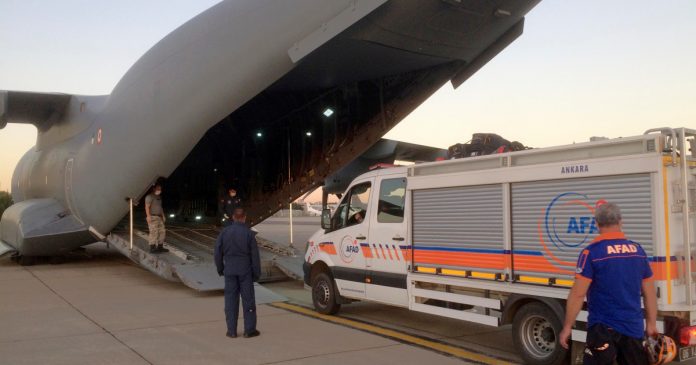[ad_1]
2021 is here and the world is still struggling with one of the most devastating pandemics of modern times. Even certain developed economies have found themselves unable to efficiently respond to this global public health emergency, while the situation in most developing countries is alarming.
The economic consequences of the pandemic have also cast a shadow on the international community’s path towards achieving the Sustainable Development Goals (SDGs) set in the United Nations’ 2030 Agenda.
In this respect, the pandemic has heightened the importance of “genuine” international cooperation.
A major part of international development cooperation relates to foreign aid, a practice that was institutionalised in the aftermath of World War II with the primary goal of rebuilding nations devastated by the conflict. Over the years, this Western-dominated system adopted different strategies, but its role in global development gradually became controversial due to the dissatisfying outcomes it attained. As a result, there are now calls for a new international aid architecture.
There are two reasons behind the existing system’s inability to produce sufficient outcomes: the lack of responsibility on part of donors for their commitments and the ineffectiveness in how aid is distributed and used.
Indeed, statistics show that there has been a huge gap between pledges of countries and their actions when it comes to foreign assistance.
In 1970, the UN General Assembly adopted an ambitious strategy which called for each economically advanced country to progressively increase its “official development assistance (ODA)” to developing countries to a minimum level of 0.7 percent of its gross national product (GNP) by 1975.
In the following years, however, only a few members of the Development Assistance Committee (DAC) at the Organisation for Economic Co-operation and Development (OECD) managed to reach this target.
Sweden and the Netherlands met the target in 1975, followed by Norway and Denmark. Luxembourg and the United Kingdom joined this group in 2000 and 2013, respectively, but no other OECD-DAC country has since met this target consistently.
It is striking that the weighted average of DAC members’ ODA has never exceeded 0.4 percent of GNP. In fact, the latest statistics reveal that in 2019, the total ODA of DAC member states was equivalent to just 0.3 percent of their combined Gross National Income (GNI).
In 2019, only five DAC members met or exceeded the 0.7 percent threshold: the UK (0.7 percent), Denmark (0.71 percent), Sweden (0.99 percent), Norway (1.02 percent), and Luxembourg (1.05 percent).
Just like in 2018, the highest ODA/GNI ratio in 2019 within the OECD dataset came from Turkey, which is not a DAC member but an observer, with 1.15 percent.
These statistics clearly demonstrate that a majority of high-income countries have ignored or only partly lived up to their commitments on development cooperation so far. This illustrates the frustrating situation that prevails decades after the UN’s adoption of its ODA strategy.
Today, as the pandemic and its economic consequences add to the hardships the developing world has long been experiencing, developed countries have a responsibility to immediately start making good on their decades-old pledge.
In this context, Turkey’s performance regarding foreign assistance in the last 15 years should be seen as an inspiring example. As data reveal, Turkey, an upper-middle-income economy, has done more than its share in terms of global aid commitments based on the principles of humanitarian imperative and impartiality under the leadership of President Recep Tayyip Erdogan.
The statistical snapshot above explains to some extent why the world’s development outlook is still below desired levels. However, inadequate funding is only one facet of the failure. While high-income and even upper-middle-income countries must give serious thought to their financial contributions, they must also focus on the effectiveness of foreign assistance. Countless development programmes and projects in the past have delivered little benefit to targeted countries and instead wasted resources.
The effectiveness of any development assistance effort rests on two pillars: design and delivery.
How foreign aid is formulated at the very beginning determines its outcome. A good design requires a multifactorial approach, including the proper identification of decision-makers and beneficiaries, as well as goals and the type of intended cooperation. For any aid effort to succeed, it also needs to be formed on the basis of humanitarian principles and genuineness.
But a good design cannot guarantee success without efficient delivery. For foreign aid to provide effective outcomes, it needs to be delivered transparently and without unnecessary bureaucratic delays. Accountability is another key factor in this regard.
In short, the countries and institutions need to come up with specific and well-thought-out formulas to efficiently deliver aid to each country in need.
Today, hundreds of millions of people around the globe are still struggling with poverty and hunger. The percentage of the world population that just gets by in substandard living conditions is still considerable. Moreover, the pandemic further crippled many developing nations’ already limited ability to lift their citizens out of poverty.
Hence, if the world wants to reach the SDGs set in the UN’s 2030 Agenda, it needs to act, and act fast. Today, donor countries have a serious responsibility to live up to their developmental aid commitments and engage in effective development cooperation. The pandemic, and the suffering it continues to cause, should serve as a striking reminder of the paramount necessity for a new international development cooperation architecture that is just, effective and functional.
The views expressed in this article are the author’s own and do not necessarily reflect Al Jazeera’s editorial stance.
[ad_2]
Source link











